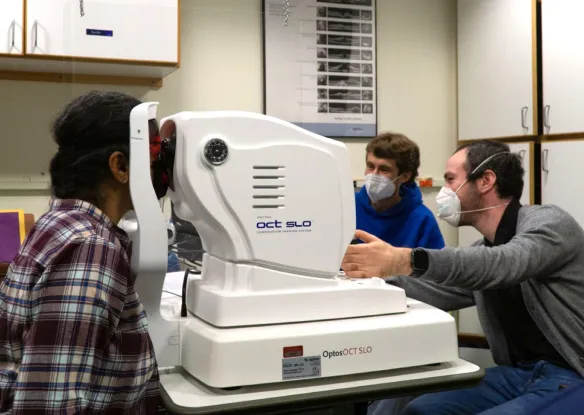Age-related macular degeneration (AMD) remains a leading cause of visual impairment in elders and has no known cure. Treatments now exist to slow the “wet” form of the disease, yet even treated individuals may benefit from low vision rehabilitation and eccentric viewing training. Much research has concerned itself with oculomotor control in these patients for reading, as it is a common complaint. The impact of visual and oculomotor disturbances on manual tasks has been almost completely ignored to date, yet good eye hand coordination is essential to tasks that we encounter in daily life, from pouring a cup of tea to making a sandwich. When maculopathy progresses to disrupt the fovea with a central scotoma or blindspot, patients develop a preferred retinal locus (PRL) in the periphery. As the PRL develops, both ocular and manual motor systems adapt to use this new location as a reference, leading some researchers to refer to the PRL as a “pseudo-fovea”. Anecdotes from the clinic suggest, however, that shortly after central vision is lost the hand still moves to locations congruent with the foveal location. In this proposal, we conduct the first comprehensive experiments on a large cohort of subjects that deliberately seek to characterize the contributions of vision and oculomotor control to reaching deficits in patients with central field loss. Behavioral data on clinical populations is typically inaccessible to basic researchers, thus we will make our resulting dataset publicly available for further research and analysis.

Principal Investigator:
Laura WalkerProjects
- Inactive
- Completed
State of the Science Conference On Rehabilitation Technology & Methods For a Changing Population
Date: Friday, December 4, 2015 Location: The Smith-Kettlewell Eye Research Institute, 2318 Fillmore St., San Francisco CA 94115 The goal of this invitation-only conference was to identify needs for future research in rehabilitation technology, methods for the blind and visually impaired population, and those with dual sensory loss. Program: 8:45 - 9:15 Check-in and coffee/pastries 9:15 - 9:25 Welcome 9:25 - 9:45 Keynote: Paul Schroeder (link to YouTube video) 9:45 - 10:45 Panel 1: Changing Populations. How should we change our approach to assessing and addressing visual impairments? (link to YouTube…
SKERI-VF
Walker et al (Renninger, Psomadakis, Dang & Fletcher, 2008) suggested a novel method to estimate the monocular scotoma area from perimetry data in macular degeneration based on (i) an optic-disc based estimation of the location of the fovea and (ii) the increase in the receptive field size with eccentricity. Here, Dr Walker and I introduce a new GUI that applies this method to data from the Optos OCT/SLO.
People
Get Involved
If you are interested in vision science or want to learn more about low vision and blindness, there are many opportunities to get involved at The Smith-Kettlewell Eye Research Institute.






